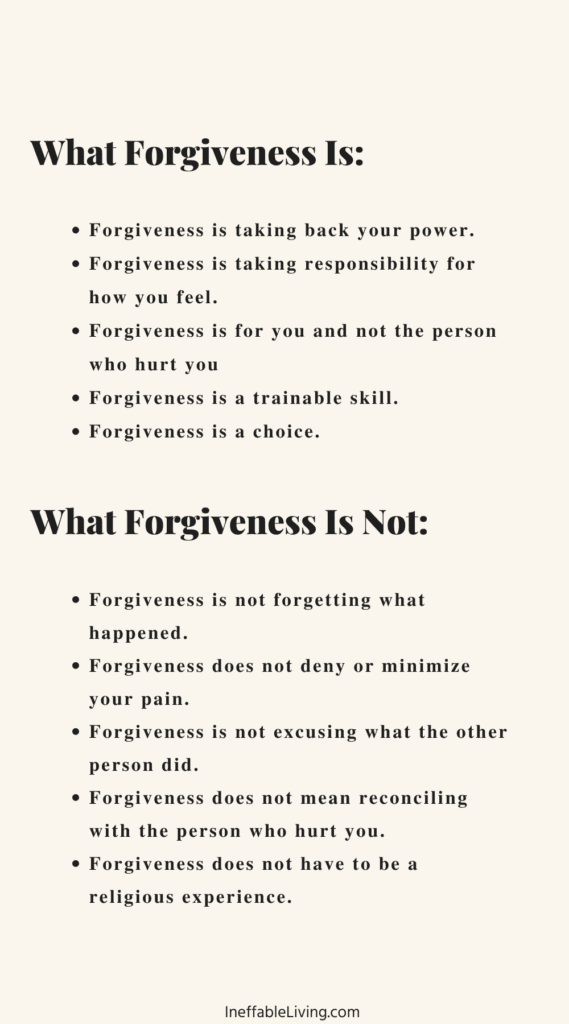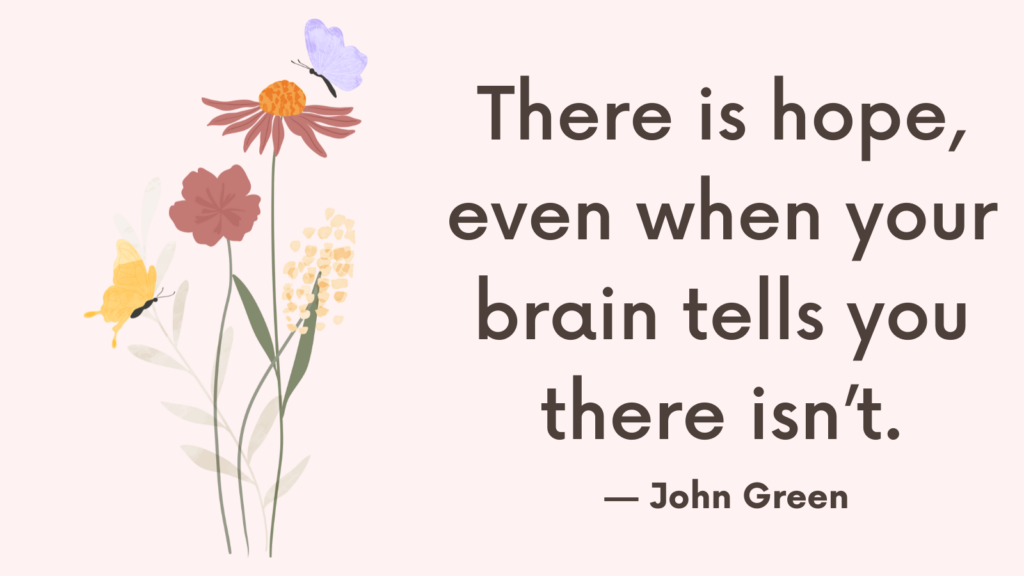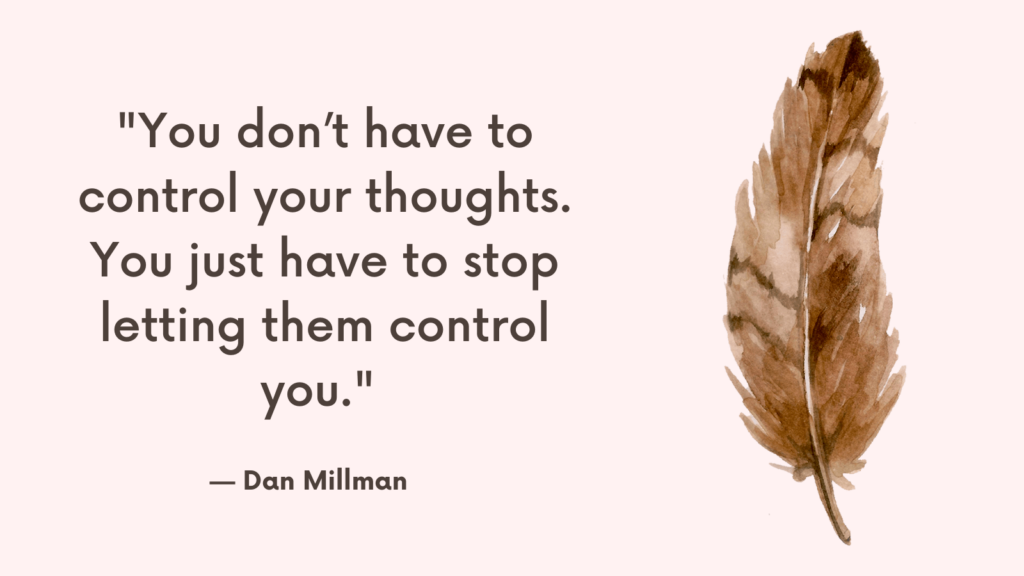Today, you’re going to learn how to know if you’ve forgiven someone and how to free yourself from the past using 9-step guide.
Forgiveness can be a powerful healing force that is always available.
But while the idea of forgiveness and its importance is not new, experience shows that it can be extremely difficult to forgive.
Oftentimes, it’s not that we don’t want to forgive. We just don’t know how.
This is mainly because forgiveness is often misunderstood and mistaken for weakness.
- How To Know If You’ve Forgiven Someone
- What Forgiveness Is?
- What Forgiveness Is Not? Common Forgiveness Myths
- Why Forgive?
- Should We Forgive Others?
- Why Is It Hard to Forgive?
- Three Levels of Forgiveness
- Two Types of Forgiveness
- How To Forgive Someone Who Isn’t Sorry In 9 Steps?
- Become More Forgiving: Practice Forgiveness Every Day
- Forgiveness Journaling Prompts Worksheets
- FAQ
How To Know If You’ve Forgiven Someone
There are different ways to know if you’ve forgiven someone:
1. Your first thought you have about them is not the harm they caused you.
2. You can think positive thoughts about this person.
3. You’re not thinking about revenge anymore.
4. You would help them if the opportunity presented itself. This doesn’t mean subjecting yourself to more harm or abuse. But it’s a detached way of helping someone in need.
5. You wish them well in life.
What Forgiveness Is?
Forgiveness is a decision to let go of the past and move on from it, including our feelings about and perception of what occurred in the past.
Forgiveness means creating a new story about what happened – a story that is peaceful and self-empowering.
Forgiveness is a decision to reclaim your life and your energy, so that you can live fully in the present moment.
Forgiveness is a choice. It does not depend on what anyone else does. It is something we do for our own benefit.
What Forgiveness Is Not? Common Forgiveness Myths
1. Forgiveness is not for the other person’s benefit.
To understand this, you need to consider how much you hurt yourself by not forgiving.
Only then can you see that forgiveness is really for your own benefit.
2. Forgiveness is not the same as reconciliation.
While reconciliation with someone doesn’t occur without forgiveness, it is possible to forgive without reconciling.
Forgiveness has nothing to do with the other person. You can forgive someone and choose not to have contact with them. You may also forgive someone who died many years ago.
Why Forgive?
The only way we can break the cycle of suffering is through forgiveness.
Forgiveness releases us from pain and the burdens of the past, and restores us to peace.
Not forgiving, on the other hand, costs us dearly.
Our perception of what happened in the past and our blame keeps us locked in a cycle of negative, destructive thoughts and emotions.
But we don’t just suffer emotionally, we also suffer physically.
Holding onto grievances can be physically debilitating. Studies show that even thinking about an unresolved conflict can cause the body to release stress chemicals and increase heart rate and blood pressure.
Should We Forgive Others?
Only Forgive When You’re Ready!
Despite the powerful healing effect of forgiveness, you should only forgive when you feel ready.
If you feel any resistance to the idea of forgiveness, don’t try to ignore or override it.
Also, keep in mind that forgiveness may not be experienced as one moment in time. It can be a process that unfolds over time.
Why Is It Hard to Forgive?
1. Blame
We encounter a wide array of challenges and suffering in our lives: heartbreak, financial loss, betrayal, illness, abuse, death, etc.
The pain can be unbearable at times. We often develop defense strategies to help us deal with the pain.
Blame is one defense mechanism we develop to reduce our pain. By holding the other person accountable, we feel a sense of relief.
However, blame doesn’t solve the problem and often prolongs the pain and reinforces it, leaving us stuck, unable to forgive, and move on.
Blame leaves us feeling powerless and victimized. We dwell on feelings of anger, self-pity, and sometimes we seek revenge. This only perpetuates our own suffering.
Related: Get Out of Your Own Pity Party: 6 Ways to Stop Pitying Yourself
2. Lack of Motivation
One of the main reasons why many people find it hard to forgive is lack of motivation – not considering the benefits we get from forgiving.
For most people, the motivation to forgive comes when the pain of carrying a grievance becomes unbearable.
Three Levels of Forgiveness
When thinking about forgiveness, we usually focus on forgiving others. But there are other levels of forgiveness.
Level 1. Forgiveness of Others
Forgiveness of others also includes forgiveness for impersonal acts – acts that can’t be attributed to specific individuals, such as forgiveness of mankind for damaging the environment, forgiveness of the government for being inefficient, forgiveness of society for being unfair, etc.
Level 2. Self-Forgiveness
When we perceive ourselves to be the victim, it can be hard for us to see how we contributed to our suffering or why should we forgive ourselves.
But the truth is, we have a part in creating any situation in our lives. At the very least, we created our story about what happened, which caused us suffering.
Level 3. There Is Nothing To Forgive
This is about the realization that at some level everything is exactly as it is intended to be, even if we don’t understand it or like it.
This is when you radically accept what happened without feeling the need to judge it as right or wrong, good or bad.
“Until you can see that there is nothing to forgive, you haven’t really forgiven. No one has ever hurt anyone. No one has ever done anything terrible. There’s nothing terrible except your uninvestigated thoughts about what happened. So whenever you suffer, inquire. Look at the thoughts you’re thinking, and set yourself free. Be a child. Start from the mind that knows nothing. Take your ignorance all the way to freedom.” – Byron Katie
Two Types of Forgiveness
1. Unilateral Forgiveness
Unilateral forgiveness is forgiveness that is internal and unconditional.
It doesn’t require the other person to apologize or show remorse for you to forgive him.
It is a process that benefits you primarily.
2. Bilateral Forgiveness
The second type of forgiveness is called “bilateral forgiveness”. It is interpersonal and conditional, given in exchange for an apology.

How To Forgive Someone Who Isn’t Sorry In 9 Steps?
Step 1. Do a Forgiveness Inventory
Examine different areas of your life and make a list of all the people you need to forgive (parents, siblings, other family members, friends, former partners, coworkers, employers, government, etc) and the things you need to forgive them for.
You may also include yourself in this list.
Step 2. Identify Your Grievance
Select one person from your list and describe your grievance in detail. Describe what happened and your thoughts and feelings about it.
Be as honest as you can when expressing how you think of what happened and how it has caused you to suffer. Don’t censor yourself.
Step 3. Describe Your Grievance Story
We create a story about everything that happens in our lives. It’s our way to relate to the world and make sense of what we are experiencing.
Therefore, most of our suffering is not caused by what happened to us, but rather, by the story we tell ourselves about what happened.
We do this unconsciously and we honestly believe our story is true and entirely factual.
But this is not true. We are indeed very selective when it comes to the facts we include and the ones we omit in our stories.
Try to deconstruct the story you tell yourself about your grievance.
Ask yourself the following questions:
- What aspects of the story have you taken personally?
- Do you blame someone else for how you feel?
- Do you see yourself as a victim?
Related: Best Edith Eger Quotes (“The Gift”): 12 Invaluable Lessons to Set Yourself Free
Step 4. Face Your Painful Emotions
To fully forgive, you need to address your feelings around what grievance story.
Many people were taught that some feelings are okay, but other feelings, like anger and hurt are not.
This is not true.
All emotions are essential to our well-being and serve a purpose. They give us important feedback about what is happening around us.
By feeling our emotions and staying connected to them, we are able to take effective action.
Rather than feeling upset about your anger, consider what the emotion is trying to tell you and use that information to take appropriate action.
Related: 6 Simple Ways to Manage Difficult Emotions and Control Them
Step 5. Consider the Impact of Your Grievance Story
This will help you find the motivation to face your hurt and let go of your grievance story.
Ask yourself how does my grievance story affect various aspects of my life experience? What is it costing me?
Consider its impact on your mental, physical, and spiritual health.
Take a moment to think about your grievance story and notice your emotions and bodily sensations.
Scan your body for any tense or contracted areas, including your chest and abdomen.
Ask yourself what do you gain from keeping the old story? What benefits do you get if you’re to let go of it?
Step 6. Find the Gift
Forgiveness is incomplete without understanding the gift of every life experience.
When you stop seeing yourself as a victim and align yourself with the realization that every situation has unfolded exactly as it was meant to unfold, you realize that there is nothing to forgive.
Although this view may be controversial, especially for people who experienced great trauma, shifting your perspective can offer great healing and personal growth.
Step 7. Consider the Good Intention
Reminding yourself of the good intention of self and others can help you reach forgiveness.
This good intention is the positive reason why, you or someone else had at the beginning of the situation.
For example, if you got into a relationship that did not turn out the way you had hoped and you feel angry with yourself, consider that your positive intention, the reason you got into the relationship in the first place, was to enjoy a healthy connection with someone else.
Step 8. Forgive Yourself
Forgiveness is incomplete without self-forgiveness.
Self-forgiveness can be more difficult than forgiving others, mainly because it’s difficult to see how or why we would need to forgive our selves.
We play a role in every situation but we can only become aware of our role when we stop blaming the other person and stop seeing ourselves as a victim.
Acknowledging your role in creating your own suffering doesn’t mean you should blame yourself. Rather, try to treat yourself with compassion, knowing that you didn’t have the perspective you now have.
Visualize your younger, less wise, and unknowing self. Consider the good intention your younger self had and release your self-judgment.
Remind yourself that life is all about learning from our experiences.
Step 9. Create a New, Empowering Story
Once you recognize your grievance story and how distorted it is, you can now create a new story – one in which:
- You don’t take things personally
- You take responsibility for your feelings
- You take back your power and no longer see yourself as the victim
The more you dismantle your old story and replace it with a more empowering one, the more you’ll liberate yourself from your suffering.
Template for Writing New Story
Start with a description of what happened then answer the following prompts:
- Because of this I felt ….
- Because of what happened I believed ….
- I now realize that …..
- I have now learned from this that …..
- This experience has enabled me to …..
- I commit to ….
- I have forgiven X for ….
- I have forgiven myself for ….
- I am grateful for ….

Become More Forgiving: Practice Forgiveness Every Day
Forgiveness is a tool of daily living, not just rare occasions.
Start forgiving the small insults and minor offenses, such as poor restaurant service, inconsiderate drivers, etc.
Imagine they are your neighbors, family members, or close friends, and feel compassion toward them.
If you find it hard to find things to forgive, consider what makes you feel angry or hurt.
Forgiveness Journaling Prompts Worksheets
FAQ
How To Respond To An Apology When You’re Still Hurt?
If you are still hurt and not ready to accept an apology, it’s okay to take some time for yourself to process your emotions.
Here are some ways you can respond to an apology:
1. Thank the person for apologizing and acknowledge their efforts to make amends. You can say something like, “Thank you for apologizing. I appreciate your effort to make things right.”
2. Be honest about your feelings. You can say something like, “I still feel hurt at the moment, but I appreciate your apology.”
3. Tell them that you need time to heal. You can say something like, “I appreciate your apology, but I need some time to process my feelings and heal before we can move forward.”
Remember, forgiveness is a process and it’s important to take care of yourself and your emotions first.

References
- Portions of this article were adapted from the book Forgiveness Workbook, © 2009 by Eileen Barker. All rights reserved.
- Research on the Science of Forgiveness: An Annotated… (berkeley.edu)
- The New Science of Forgiveness | Greater Good (berkeley.edu)
- Forgiveness: Your Health Depends on It | Johns Hopkins Medicine
- Forgiveness can improve mental and physical health (apa.org)
- Forgiveness of others and subsequent health and well-being in mid-life: a longitudinal study on female nurses | BMC Psychology | Full Text (biomedcentral.com)
- Frontiers | The Influence of Decisional and Emotional Forgiveness on Attributions | Psychology (frontiersin.org)
- Psychology of Forgiveness: 10+ Fascinating Research Findings (positivepsychology.com)
- Forgiveness, Stress, and Health: a 5-Week Dynamic Parallel Process Study – PMC (nih.gov)
- The power of forgiveness – Harvard Health
- Forgiveness: Letting go of grudges and bitterness – Mayo Clinic
- What Really Feels Better, Forgiveness Or Revenge? New Research Has An Answer (forbes.com)



